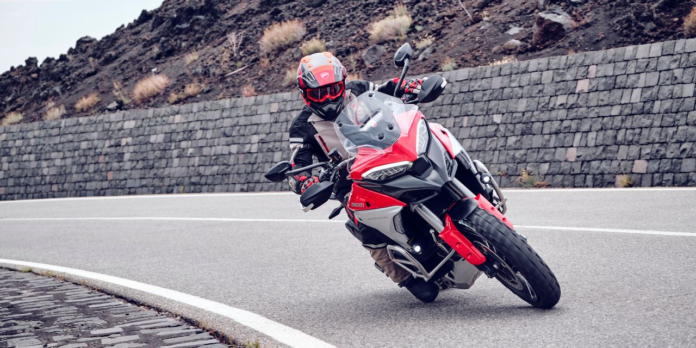I REGRET ever throwing a leg over the 2021 Ducati Multistrada V4 S ($24,695, as tested), the company’s beguiling touring bike of unusual size, now equipped with adaptive cruise control and blind-spot detection. It filled my helmet with a lot of wrong thoughts, shameful thoughts, that years of therapy were supposed to cure. I again feel a love that dare not speak its name, around my house anyway: motorcycle.
Not just any motorcycle, but a long-legged, stouthearted, perfectly balanced Italian sport tourer (max 33.9-inch seat height) brandishing rock plates and crash bars, with two-up seating and ride-height adjustable suspension, (optional) heated grips and two-position seat heaters, and a six-speed semiautomatic gearbox whose clutchless shifts are sweeter than angels’ kisses. I think in Kentucky it’s legal for us to get married.
“ Multistrada’s mirrors, alerting me to vehicles I didn’t see, reminded me how undefended my six o’clock usually is. ”
While the Multistrada’s variety of Automatic Driver Assistance Systems (ADAS) is commonplace in automobiles, this is the first application on a series-production motorcycle. I’m a big fan. Relying on front and rear-mounted radar emitter/sensors integrated into the fairing, and answering to a clever switch array built into the left grip, the Multistrada’s ADAS functions are easy to set, easy to use and easy to rely on, from 18.5 to 99.4 mph.
When traffic ahead slows, the bike winds down the throttle, in sync, even brushing the brakes to keep a preset distance. As traffic speeds increase or the lane ahead clears, the bike will roll on the gas, signaling for upshifts, as necessary. Ghost rider requesting a tower flyby.
RADAR LOVE Multistrada’s adaptive cruise control maintains a preset distance from the traffic ahead, using throttle adjustments and light braking. If the closing rate is too high the system will alert the rider. Photo: Ducati
The adaptive system will automatically disengage if riders touch the brakes or hold in the clutch, if they lean over more than 50 degrees, or if they let speeds drop below the minimum. So they don’t fall over on their scarlet jock rocket.
Among the supporting technologies is the six-speed semiautomatic gearbox, starring a multi-plate wet clutch with hydraulic control, providing clutchless upshifting and downshifting. This was my first go with one of these toe-tapping gearboxes, called Ducati Quick Shift. Fabulous, flawless. Its instantaneous upshifting behavior feels very much like the paddle-shift actuation of an Audi R8.
I’m also loving the blind-spot alert, whose amber indicators are integrated into the Multistrada’s side mirrors. Of course, like all surviving riders, I reflexively check mirrors, signal and look over my shoulder before I change lanes. But typically just a glance, stolen at a cost of forward attention, past limited peripheral vision due to the helmet. The cheerful amber in the Multistrada’s mirrors, alerting me to vehicles I didn’t see, was a constant reminder of how undefended my six o’clock usually is.
Introduced in 2003, the Multistrada has been marketed as an adventure bike, denoting on- and off-road use; but in many ways it has been the least trail-ready among its obvious competitors, which currently include BMW’s R 1250 GS, the KTM 1290 Super Adventure R, Harley-Davidson’s new Pan America and Honda Africa Twin.
The fourth design generation of Multistrada levels things up nicely, but doing so meant sacrificing some of Ducati’s most sacred cows, including L-twin engine with desmodromic (springless) valve train, the single swing-arm design, and the trademark trellis frame. The new bike has an aluminum monocoque. My old stage name.
Based in Bologna and owned by VW Group, Ducati’s business challenges include the high costs of ownership, partly due to the finicky valve train, descended from race bikes of the mid-20th century. The service interval for early Multistradas was as frequent as every 6,000 miles with valve maintenance scheduled every 18,000 miles. Thus Multistradas’ reputation as trailer queens and service-bay vagrants.
BLOODLINES The Multistrada has an aluminum monocoque design that replaces the brand’s distinctive frame, with its red-painted trellis-style detailing now confined to the seat cantilever. Photo: Ducati
The 2021 edition is fitted with the company’s new 1,158-cc 90-degree V4 engine, shared with Ducati’s Panigale, with the characteristic counter-rotating crankshaft and twin-pulse firing order. However, in the Multi, the desmo works have been subbed out for conventional return-spring actuation. The V4’s output (170 hp and 92 lb-ft) is about the same as the previous L-twin. But the first oil change is scheduled for 9,300 miles and the first valve inspection/adjustment isn’t due until 37,300 miles. So that’s progress.
Listening from the saddle, it’s clear a certain ordinariness has crept into the Multi’s breathy idle note, absent the desmo’s chiming. On the other hand, the engine’s refinement, engagement and rideability is much improved. The L-twin kind of hated near-idle speeds and had a tendency to snatch, rattle and lug in first-gear operations.
The V4’s poise is unflappable. Accelerating from walking pace, the bike can roll off in 2nd gear with nary a shudder. The exhaust note is rich, percussive but surprisingly muted. Euro motorcycles are getting quieter every year.
So, seriously, has there ever been a more comfortable, more centered touring motorcycle? The Multi’s upright, natural riding posture can be sustained for hours. The saddle is soft and narrow, with optional heaters for rider and passenger. The grips are well shielded from the wind. The adjustable windshield rises high enough to fully deflect airflow over the rider’s helmet—so no helmet buffeting at high speeds. Sustained wind noise is fatiguing and can cause temporary hearing loss, forcing you to shout your order at the barista: Triple-shot grande latte, please!
The handling is light, laughably nimble and reactive for so large a bike (536 pounds). Flicking left and right, the Ducati feels like half its weight. You’ve got your monster Brembo four-piston monobloc brakes up front, with cornering ABS, and Pirelli Scorpion Trail II tires around staggered wheels (19-inch front and 17-inch rear). Our test bike featured the optional crossed-laced spoke wheels with tubeless beadlocks. They look nice.
No, Mr. Multistrada is not perfect and certainly no cheap date. The V4 S gets awful miles.
According to the bike’s computer, I am on pace to get 145 miles out of 5.8 gallons, or about 25 mpg. Gas stations will be a big part of owners’ touring adventures.
Of course, ADAS systems can’t hope to make motorcycles completely safe, only safer. Riding a hoss like the Multistrada will always be something of a calculated risk; fortunately, math was never my strong subject.
2021 Ducati Multistrada V4 S
HIGH AND TIGHT Ducati’s big touring adventure bike is narrow in the saddle and broad at the handlebars. The unladen curb weight is 536 pounds. Photo: Ducati
Base price: $24,095
Price, as tested: $24,695
Powertrain: 1,158-cc 90-degree DOHC V4 with ride-by-wire control and cylinder deactivation; six-speed manual transmission with clutchless upshifting; dual rear swingarm and chain drive
Power/torque: 170 hp at 10,500 rpm/92 lb-ft at 8,750 rpm
Wheelbase/seat height: 61.7 inches/33.1-33.9 inches
Rake/trail: 24.5 degrees/4.0 inches
Curb weight: 536 pounds
Observed fuel economy: 25 mpg
The Wall Street Journal is not compensated by retailers listed in its articles as outlets for products. Listed retailers frequently are not the sole retail outlets.
Corrections & Amplifications
The Ducati Multistrada V4 S has an 1,158-cc engine. An earlier version of the vehicle’s specifications misstated its cubic capacity. (Corrected on May 14)
2021 Ducati Multistrada: A Touring Bike With a Safer, More Centered Ride
RELATED ARTICLES




